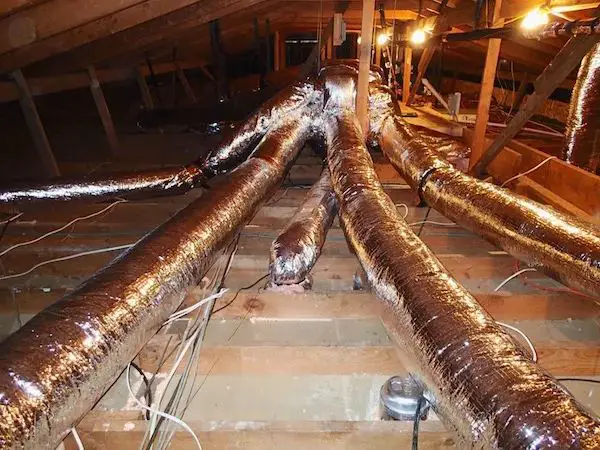What Is R6 Flex Duct?
What is R6 Flex Duct?
R6 flex duct is a type of flexible ductwork used in HVAC systems, specifically in heating, ventilation, and air conditioning. The “R6” refers to the duct’s insulation rating – R6 ducts have an insulation value of R-6, which means they provide a resistance to heat flow of 6 ft2×h×°F/Btu.
Flex ducts like R6 are constructed using an inner core of wire helixes wrapped in insulation, usually fiberglass, then covered with a vapor barrier or sleeve. This allows the ductwork to be both insulated and flexible for routing through walls, ceilings, and floors. The flexibility makes installation much easier compared to rigid sheet metal ducts.
R6 flex ducts are designed for use in residential HVAC systems. The R6 insulation helps minimize heat loss/gain and condensation when conditioned air passes through the ducts. This improves energy efficiency and indoor comfort. R6 ducts are commonly used for supplies, returns, and runs between HVAC equipment and registers/grilles. The vapor barrier protects against moisture intrusion as well.
Overall, R6 flexible ductwork provides an insulated, easy to install solution for distributing conditioned air through a home’s ductwork. The R6 rating gives a moderate level of thermal resistance to reduce energy losses. R6 ducts meet code requirements for most residential applications.
History of R6 Flex Duct
R6 flex duct was first introduced in the 1970s as an improvement over previous insulation values like R4.5. It provided better thermal performance and efficiency for HVAC systems. Key innovations included:
Introducing a double layer of insulation with an air gap in between. This “thermal break” improved insulation performance. [1]
Using a reinforced metalized outer vapor barrier. This improved durability and prevented moisture intrusion. [1]
Optimizing insulation thickness to provide an R6 rating. This became the new standard for flex duct insulation. [2]
R6 flex duct surpassed previous products and set a new benchmark for efficiency. It has continued to be an HVAC industry standard for the past 40+ years.
[1] https://www.siglers.com/20kmr6-kmr6-flex-sharp-green-print-20kmr6.html
[2] https://www.siglers.com/thermaflex-km-insulated-flex-duct-r6-8-x-50959456673.html
Benefits of R6 Flex Duct
R6 flex duct provides several advantages over traditional sheet metal ductwork:

Flexibility – The flexible nature of R6 duct allows it to bend and move to fit tight spaces and route around obstacles, making installation much easier than rigid ductwork. The flexibility also allows the duct to flex and move as the building settles without breaking or leaking.
Ease of installation – R6 duct is lightweight and easy to cut to length on site. Installers don’t need specialized tools or equipment and can connect sections with duct tape or zip ties. This makes installation much quicker and simpler compared to sheet metal ducts.
Energy efficiency – The insulation wrap on R6 ductwork minimizes conductive heat loss or gain as air passes through the ducts, helping to maintain proper temperatures and reduce energy costs. The sealed outer vapor barrier also prevents cooled or heated air from escaping the ductwork.
Improved airflow – The inner liner is smooth which reduces turbulence and restriction as air flows through the duct. This results in better airflow and reduces resistance and pressure loss compared to bare sheet metal ducts.
Overall, R6 flexible ductwork combines flexibility, ease of use, efficiency, and performance – making it an ideal choice for many HVAC installations.
Limitations of R6 Flex Duct
While R6 flex duct offers benefits like affordability and flexibility, it does have some limitations to consider:
Durability issues – R6 flex duct is prone to punctures, tears, and brittleness over time more so than rigid metal ductwork. It must be properly supported and handled with care during installation. According to this Hunker article, R6 duct can degrade faster than R8 duct when exposed to UV light, humidity, dust, and dirt.
Potential for leaks – The seams and joints on R6 duct are more prone to air leaks compared to metal ductwork. Proper installation using mastic sealant or aluminum tape is crucial to minimize leakage. Duct supports must be installed per code to avoid sagging and disconnected joints. Periodic inspections and maintenance checks should look for leaks or holes in the ductwork.
Noise transmission – R6 duct tends to transmit more fan and airflow noise than rigid metal ducts. The thinner insulation provides less sound dampening. Using acoustic liners or sound attenuators, as well as proper sizing and smooth transitions, can help reduce noise.
R6 Rating Explained
The R6 rating refers to the thermal resistance or R-value of insulation used in flexible ductwork. R-value measures the effectiveness of insulation materials in resisting heat flow. The higher the R-value, the better the insulating performance.
The R6 rating means the insulation has an R-value of 6. Typical R-values for flexible duct insulation range from R4.2 to R8.
Compared to other common ratings:
- R4.2 is the minimum insulation value allowed by building codes for HVAC flexible ducts.
- R6 provides moderate insulation and is commonly used for residential HVAC systems.
- R8 offers 25% better insulation than R6 and is recommended for very hot or cold climates.
So in summary, the R6 rating indicates a medium level of insulation performance designed for general residential use. R6 strikes a balance between cost, durability, and energy efficiency.[1]
Codes and Standards
R6 flex duct is designed to meet relevant HVAC codes and industry standards. The key codes and standards include:
Complies with NFPA Standards 90A and 90B – Meets National Fire Protection Association standards for installation and maintenance of air conditioning and ventilating systems.
Meets California Prop 65 requirements – Contains no chemicals known to the state of California to cause cancer or reproductive toxicity.
Adheres to UL 181 and UL 181A standards – Complies with Underwriters Laboratories’ safety requirements for closure systems and flexible air ducts.
ASTM C518 – Meets American Society for Testing and Materials standard for thermal insulation products.
ICC-ES AC101 – Verified by the International Code Council Evaluation Service for use as flexible air duct material.
R6 flex duct is engineered to satisfy key HVAC codes and standards for safety, performance and reliability when properly installed.
Cost Comparison
R6 flex duct is more expensive than regular uninsulated flex duct, but it provides better efficiency and performance. Compared to sheet metal ductwork, R6 flex duct is often a more affordable option.
R6 duct has an insulation value of R-6, meaning it provides moderate insulation. It costs more than basic R-4.2 and R-4.3 flex duct, but less than premium R-8 flex duct. According to Home Depot, 6-inch R6 flex duct costs around $1.30 per linear foot. R-4.2 duct costs about $0.90/foot while R-8 is around $1.70/foot.
The higher cost provides better insulation and efficiency over bare sheet metal or basic insulated flex ducts. R6 can help meet energy codes in many areas. Though more expensive upfront, it can pay off through lifetime energy savings.
Installation Best Practices
Proper installation is critical for R6 flex duct to perform as designed. Here are some best practices to follow:
Sizing
Size the ductwork according to standard methods based on airflow requirements. Oversizing the ducts can reduce system performance. Carefully follow manufacturer instructions for minimum bend radius and maximum lengths.
Supports
Use hangers or straps to properly support flex duct runs. Supports should be placed every 4-5 feet along horizontal runs to prevent sagging and maintain the intended shape. Avoid compressing or deforming the duct with excessively tight hangers.
Bends and Elbows
Avoid sharp bends or kinks that can restrict airflow. Use sweeping elbows and long radius bends wherever possible. Follow the minimum bend radius recommendation from the manufacturer, usually 1-1.5 times the duct diameter.
Sealing
All connections and joints must be properly sealed with approved tapes or mastic to prevent air leakage. Pay close attention to sealing the ends connecting to equipment, registers, plenum boxes etc. Duct leakage can reduce system efficiency and performance.
Insulation
Wrap all ductwork with the recommended insulation thickness to prevent energy loss and condensation. Secure insulation using proper tapes or fasteners designed for R6 flex duct. Insulation also helps maintain the duct shape.
Testing
Perform leakage testing after installation to verify proper sealing. Repair any identified leaks. Leakage rates should not exceed specifications based on duct type and application.
Maintenance Tips
Proper maintenance of R6 flex ducts is important to ensure optimal HVAC system performance. Here are some tips for maintaining flex ductwork:
Regularly inspect the ducts for any leaks, tears, or damage. Small leaks can lead to loss of airflow and pressure, reducing system efficiency. Inspect all joints, seams, and connections closely. Listen and feel for air leaks. Use duct sealant or aluminium tape to repair any minor leaks or gaps [1].
Clean the ducts regularly, especially if they are exposed to high traffic areas with more dust and debris. Use a soft brush attachment and vacuum to remove dust buildup on the exterior. Avoid using liquids or harsh chemicals inside flex ducts, as they can damage the inner liner. Consult an HVAC professional for deep duct cleaning services if necessary.
Replace any sections of duct that are too damaged or degraded to be repaired. Look for tears, holes, dents, kinks, or melted spots. A damaged section can restrict airflow. Replacement is relatively easy by cutting out the affected portion and reconnecting the duct. Proper support should be installed to prevent future damage [2].
Future Outlook
The future of R6 flex duct looks positive as it remains a popular and cost-effective option for many residential HVAC systems. While strict energy codes in places like California are phasing out R6 in favor of higher R-value ducts, R6 ducts are still permitted in most areas. With its moderate insulation, flexibility, and affordability, R6 flex duct will likely remain commonplace for the foreseeable future.
Some new developments that may impact R6 ducts are advanced materials that improve insulation performance without sacrificing flexibility or cost. For example, aerogel insulation and layered polymer fabrics can achieve higher R-values. However, these newer materials have not yet gained widespread adoption. As energy codes evolve, R6 flex duct will face increasing competition from higher-performing solutions. But with its proven track record and advantages, R6 remains popular for cooling and heating systems across North America.





